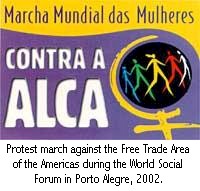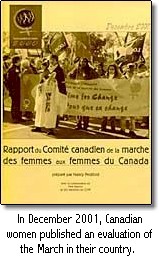Because the struggles must continue, and the gains are sometimes fragile, member groups of the March are working to ensure that feminist networks remain strong and capable of reacting to any attacks on women's rights.
In Colombia, despite "the war that absorbs all our time and actions," according to an activist, the March network and resistance to globalization continue to be important to women. In August 2001, women held a march in the oil-producing region, where there is a large presence of paramilitary groups. A steering committee of Colombian women's groups was formed with the aim of elaborating peace proposals.
Women in Hong Kong are challenging government policy concerning Filipino immigrant workers and denouncing prostitution and militarization in Southeast Asia.
Dutch women are engaged in a dialogue with women from different countries "to share information, study feminist issues and examine the impact of the new information technologies on political activism."
Women of New Caledonia are organizing to acquire economic resources for tribal women and to protest the Island's refusal of the amendment granting political parity to women.
In Guatemala, women are continuing to present their demands to justice officials and to specific government and ministry officials. They are calling for training on alternative natural medicine and educational centres for violent men.
In Mexico, the March committee is planning to launch a campaign for women's economic and social rights that focusses on public policy, solidarity economics, and transformation leading to a non-violent culture. They are planning a national event to publicize the results of the March. Together with other women's groups, March participants succeeded in blocking the presidential decree raising taxes on food, education and drugs.

Women in Brazil were very involved in preparations for the World Social Forum in Porto Alegre, and they continue to organize marches.
Haitian women participated in an international workshop held in June 2001 entitled "Poverty and Development Strategy," that was attended by officials of the IMF and World Bank.
Palestinian women are working in support of the Intifada. The March calls on Israel to respect international law and UN Security Council resolutions, withdraw from the Gaza Strip and East Jerusalem, and recognize the Palestinian State. In June 2001, 3000 people participated in a night vigil in Israel. Palestinian women and men from the occupied territories were present. Citizens of the two communities who aspire for peace have conducted a number of joint actions.
To be continued
Much remains to be done, and we must not allow the mobilizing strength generated by the March to wane. "How can we channel the mounting anger of women and of other social movements? How do we assure that mobilization on this grand scale has an impact?" ask Québec women who are discussing the usefulness of creating a left-wing feminist alternative: "the struggles must be located within a long-term movement."

Should certain strategies be revisited; should we continue putting our energy into campaigning for reform of the UN, IMF and World Bank, or should we, on the contrary, develop a stronger presence in the other social movements?
The link between capitalism and patriarchy, central to our analysis of globalization and its impact on women, also suggested alternative paths to the dominant system. Springing from this analysis, collective actions were developed and carried out.
The questions, however, remain unanswered. How can we share the wealth, maintain social services and genuinely integrate women into the work world? How are we to make global progress in eliminating violence against women? The March must fine-tune its responses to these questions.
We must take our place in all protest movements and be a presence at the international conferences. It has been proposed that the March create an alert network that would respond whenever women's rights are under attack.
Wherever decisions are made and political strategies debated, the March must make sure a feminist perspective is included in order to ensure that it is not diluted or lost among other concerns and viewpoints.
In 2001, new work groups were formed to study these questions and explore the use of the Web and new technologies as tools for mobilization.
One of the groups is working on the restructuring of the March. March participants want to assure stronger participation of grass-roots groups and establish contacts in regions where the March has not yet made significant inroads.
Functioning should be more participatory and decentralized; also differences among women themselves should be taken into account more - a point emphasized by Indigenous women who found that this was not always the case.
The years 2001 and 2002 have been years of transition, evaluation, engagement and continuation; years of reviewing and renewing priorities, updating and improving the demands, forging new alliances and reaffirming old ones. They have been rich not only in reflection, but also in action and emotion.
Millions of women joined the World March of Women. Born of a utopian dream, the March then took form, eliciting new expressions of solidarity and uniting women around common concerns. Women took up the call with enthusiasm and determination: from now on, nothing will stop us.






